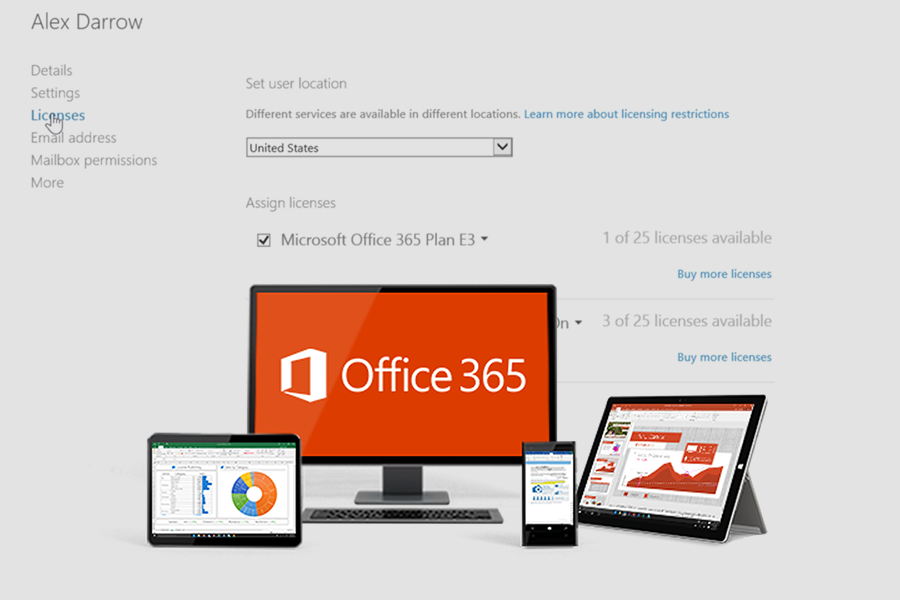Top 5 tips for managing and reducing your Office 365 subscription costs
Need to optimize your Office 365 provision and migration? Here are our top 5 tips for managing and reducing your Office 365 subscription costs for Software Asset Managers.
1. Office 365 role based provisioning
As all software asset managers know, Microsoft love SKUs, and Office 365 is no exception. It’s unlikely that one SKU, or in Office 365 terminology ‘plan’, will be optimal across your entire employee base. Office 365 has lots of functionality, from email to PSTN conferencing, online web apps to a fully installed desktop suite. Ideally each employee should only have functionality required for their role; this ideal might not be fully achievable within the plans available but you should ensure there isn’t a massive discrepancy. For example, none or infrequent IT users like retail staff or drivers shouldn’t be consuming an expensive fully featured Office 365 E5 license when an Office 365 E1 or Office 365 K1 license might be sufficient. Perform an audit of how Office is currently installed on your network and understand its usage; this will help you plan user profiles, establishing who needs what functionality.
2. Strengthen links with HR
Ensure users in your Office 365 Admin Center accurately reflect the current status of employees within your organization. Integrating Office 365 user provision with HR’s Joiners/Movers/Leavers processes should ensure new employees have access to Office 365 functionality from day one and free licenses for reuse when employees leave. Managing the assignment of Office 365 licenses in the Joiners/Movers/Leavers processes also ensures you only ever purchase the actual number of licenses needed come renewal.
3. Eliminate Office perpetual license redundancy
Ensure users aren’t double licensed for traditional perpetually licensed Office and Office 365. As you move from the traditional model of purchasing Office with a perpetual license (possibly via an Enterprise License Agreement) to an Office 365 subscription plan there is scope for been over licensed, this should obviously be avoided. Users covered by an Office 365 plan should be removed from perpetual entitlements, doing so could reduce associated costs such as software assurance. It’s important that the benefits of your enterprise licensing agreement are understood as they may no longer be required if they are implicitly built-in to your Office 365 plan, however this may not always be the case so be sure to check.
4. Active directory account reconciliation
User account reconciliation against HR, Active Directory and Office 365 allocations provides a helpful check and if needed balance to ensure your Office 365 expenditure reflects your current personnel requirements. It’s obviously timely to perform such checks before renewal however regular and ideally automated user reconciliation and synchronization also provides wider productivity and security benefits to both HR and IT teams.
5. Capitalise on existing perpetual license investment
Before moving to Office 365 understand your current entitlements for perpetually licensed Office. This process should also include entitlements for on-premise server applications such as SharePoint and Exchange which may be included in your new Office 365 plan. Having a clear understanding of what you own today will ensure you don’t double license going forward. You may also be entitled to bridge licensing where you can maintain the same level of on-premise licensing without buying CALs by leveraging your Office 365 licenses to access on-premise servers. Having a clear understanding of your existing investment in on-premise CALs and perpetually licensed software will also influence what Office 365 plan is required and may help negotiate terms which capitalize on your existing software investments.
Bonus Tip
Consider using Vizor to manage your Office 365 provision and migration. Vizor’s unique role based provisioning capability intelligently recommends exactly what software, including specific Office 365 plans, each employee requires for their role. Vizor can also manage the on-boarding and allocation of Office 365 for new employees and recycle licenses when they leave. Core to Vizor’s software asset management functionality is a central entitlement repository which holds details on both on-premise perpetual licensed software and subscription plans such as Office 365. Having all your entitlements and agreements in one place eliminates license redundancy and helps manage the migration process from traditional Office to Office 365.
Struggling to manage Cloud Apps?






